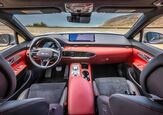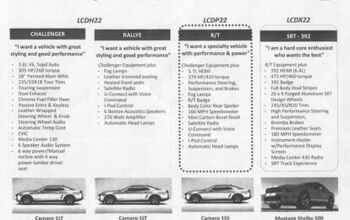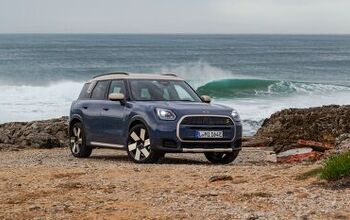2011 Dodge Challenger Review

It’s amazing how the muscle car wars – all but dead a decade ago – have reached pretty amazing heights. Both the Chevrolet Camaro and Ford Mustang get better each model year, with power boosts, chassis changes and visual tweaks bringing a steady flow of news and anticipation from the collective fan-base.
FAST FACTS
| 1. Replacing the old 250-hp 3.5L V6 for 2011 is a new 305-hp 3.6L unit. |
| 2. Base models have increased slightly to $24,670; up from $23,245 in 2010. |
| 3. The HEMI R/T model makes 371-hp with a 5-speed automatic and 376-hp with a 6-speed manual. |
| 4. While fuel economy is improved for 2011, an 8-speed automatic transmission is set to join the lineup soon and help deliver significantly better numbers. |
The third player in the trio, the Dodge Challenger, has been relegated to second-tier status. Not because it’s lacking any visual drama – no, the retro-coupe still hits hard in that regard. But simply because its extra weight, softer manners and less potent engines made it more a boulevardier than an outright performer.
For 2011, fixing the Challenger is one of a dozen projects that Chrysler is tackling. Good thing that the basics are solid, requiring a decent, but not unreasonable amount of work to improve.
VASTLY IMPROVED BASE V6 WITH LOTS MORE POWER
Seeing as a muscle car is defined by its engines, we’ll look under the Challenger’s long vented hood first. Thankfully, the old 250-hp 3.5-liter V6 in the base models is replaced by the new Pentastar V6, using variable valve timing and other tricks to deliver a full 305-hp out of 3.6-liters. That’s identical to the 2011 Mustang’s 3.7-liter, but down 7 down on the updated ’11 Camaro.
The difference in performance on the 3,800-lb base model is amazing, and should improve even more when an eight-speed automatic transmission replaces the aging five-speed automatic, which is the sole choice with the SE V6.
As an added bonus, the base engine improves the Challenger’s fuel efficiency too, although official test numbers have not been released.
While the standard ‘six’ can no longer be considered a “secretary’s car”, optioning up to the 5.7-liter HEMI is where the blood starts pumping. Running in higher tune than before, the V8-powered R/T produces 372-hp and an even 400 lb-ft with the standard five-speed automatic transmission or 376-hp and 410 lb-ft of torque when mated to the optional six-speed manual. With either transmission, the Challenger is well into the high-fives for the 0-60 mph dash. The revised MDS system, which shuts off a bank of cylinders at cruising speeds to save fuel, should help improve the results here too.
SIGNIFICANT SUSPENSION CHANGES YOU CAN REALLY FEEL
The rear-wheel-drive platform shared with the Dodge Charger and Chrysler 300 has been heavily retuned for better performance, and not just in the V8 versions. There are new mono-tube shocks, springs and bushings, while the rear multi-link gets new geometry to better control camber and toe. Finally, the front- and rear-stabilizer bars are larger to keep the body flatter when cornering.
The base Touring suspension is tighter and more responsive, and gets wider 18-inch wheels and tires. Stepping up to the Performance tune, optional on the V6 and standard on R/T, there are more aggressive brakes and optional 20-inch wheels with all-season performance tires.
For those looking for even more ability, the Super Track Pak, exclusive to the R/T, gets 20-inch wheels with sticky performance tires, heavy-duty shocks and springs, high-performance brake pads and switchable ESC.
The changes successfully tie down the big Challenger to the road, and the new electric power steering provides decent feel for such a large, heavy ride. Obviously, the Dodge wouldn’t be your first choice for an autocross, but it’s very happy with big sweeping corners and elevation changes. Places where you can get that big HEMI working hard, listening to the exhaust roar as the gas pedal flattens.
DODGE DESIGNERS DIDN’T MESS WITH A GOOD THING
Thankfully, Dodge did not make too many changes to the still-iconic exterior. The lower air intake is larger and looks almost like it was turned upside down, and the black front splitter is bigger too. The chromed fuel-filler door and dual exhaust are standard on every model.
Equally minimalist changes have been made inside with a thicker steering wheel, more comfortable and supportive front seats, a leather-wrapped shift knob and a revised instrument panel. A full-on refresh like the ’11 Journey, Avenger and Grand Caravan is still a couple years away, but the cabin is comfortable for long cruises, and the back seat is actually usable by real-sized humans.
Base SE Challengers start at $24,670 and come standard with a six-speaker sound system, cruise control, keyless entry and ignition, climate control, power windows and locks, power-folding mirrors, and 60/40 split-folding rear seat, along with six air bags, ABS and ESC.
The SE Rallye package ($26,670) adds Bluetooth hands-free and streaming audio, a USB and aux input jack, Sirius satellite radio, leather seats, an upgraded stereo and fog lamps to the V6 model. The V8-powered R/T gets the tech from the Rallye pack standard and starts at $29,670.
As with the other modern muscle cars, there are tons of options, appearance packages and accessories to completely personalize the Challenger, both in V6 and V8 versions, including throw-back R/T Classic ($32,970) or individual items like the Mopar T/A-style hood, a Go-Wing spoiler and big retro graphics.
THE VERDICT
So has Dodge’s attention made the Challenger more of a challenger? Sure has. It always had the personality, but now it has the performance – both in a straight line and in the twisties – to run with the Chevy and Ford. And with only a minor price increase too.
RELATED READING
LOVE IT
- New base V6
- Better performance in turns
- HEMI V8
LEAVE IT
- Still heavy
- Interior improved, but nowhere near perfect
- Glitchy uConnect hands-free

Mark has worked as an automotive journalist for over 10 years, starting as a student at Centennial College, in Toronto, by launching an auto-review section in the college paper, The Courier. Since then, he's been Editor of Inside Track Motorsport News and its Streetwise section of new-vehicle reviews and industry news, done stints at Carguide and World of Wheels, and currently works as an award-winning freelancer for AutoGuide.com, MSN Autos Canada and more. He's also a first-time father, so don't be surprised if the frustration of properly installing a car seat creeps into his work.
More by Mark Atkinson































Comments
Join the conversation